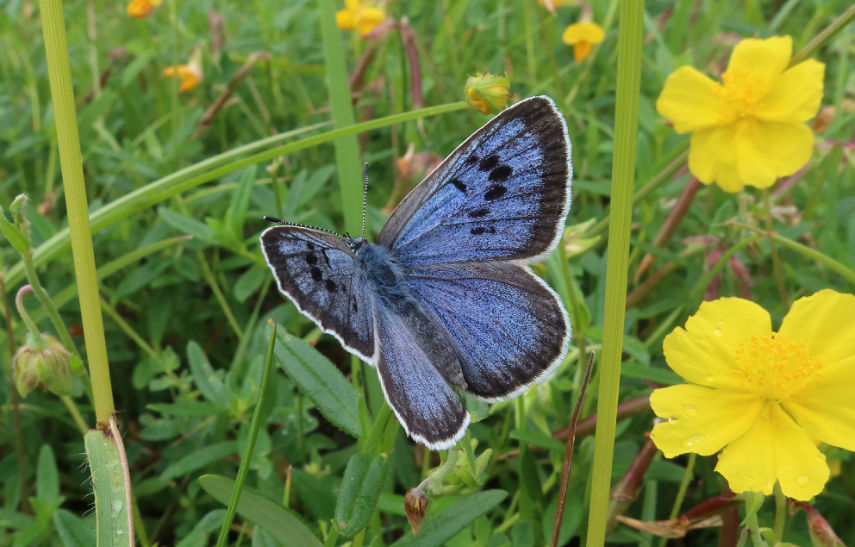Nature & Wildlife | Posted on August 25th, 2022 | return to news
Large blue butterflies breeding at the highest levels for 150 years
A once-extinct butterfly with a bizarre life cycle that includes tricking red ants into nursing its caterpillars underground is on the increase.

Reintroduced to the UK in 1983, the large blue butterfly flew in its greatest numbers since records began on the largest number of sites in 2022.
Thanks to meticulous conservation management by a partnership of scientists and conservation bodies, southwest England now supports the greatest concentration of large blues known in the world.
The large blue has a bizarre life cycle.
Having fed for three weeks on the flowers of wild thyme or marjoram, the caterpillar produces scents and songs that trick red ants into believing it is one of their own grubs, and is carried underground into the ant nest and placed with the brood. The caterpillar spends the next 10 months feeding on ant grubs before pupating in the nest the following year, then emerging to crawl above ground as a butterfly.
Despite over 50 years of efforts to halt its decline, the large blue was pronounced extinct in Britain in 1979.
Its reintroduction in 1983 was based on the discovery that large blue caterpillars can only survive in the nest of one particular species of red ant, Myrmica sabuleti. Changes in countryside management were responsible for the extinction. Alterations in grazing left surviving wildflower meadows too tall and shady for the heat-loving red ant. These trends have now been reversed through targeted grazing – tailored to optimise the structure of the turf on each interconnected site – across two UK landscapes to date.
As knowledge increased, it was possible to create new large blue habitat ‘from scratch’ on arable land, failed plantations and new railway constructions – the ultimate test for what is already the largest-scale, longest-running successful conservation programme for any endangered insect in the world.
A total of 12 new sites are being restored to flower-rich meadows suitable for large blue breeding, either ‘starting from scratch’ on arable land, failed conifer plantations and railway constructions, or by restoring bespoke grazing to degraded downland. Already, these support up to a third of the UK population of large blues, up from just 7% in 2019.
These restorations of a disappearing type of wild meadowland have also provided ideal breeding grounds for numerous other rarities that share the large blue’s habitat. Among plants, the extremely rare pasqueflower and cut-leaved self-heal have reappeared and/or spread under ‘large blue management’, together with up to 12 species of orchid.
A remarkable number of insects has increased on, or newly colonised, the 12 restorations. Nationally threatened species include the shrill carder bee (UK’s second most endangered bumblebee), rock-rose pot beetle (known from just five UK sites), the downland villa beefly (not recorded in UK for 50 years prior to 2000), and the weird rugged oil beetle (only found on around 30 UK sites). Eight Red Data-listed butterflies – Duke of Burgundy, small blue, Adonis blue, brown hairstreak, white-letter hairstreak, small heath, grizzled skipper, dingy skipper – are also thriving alongside abundant displays of more common or local insects and plants.
These restorations represent the largest and most innovative next phase of the re-establishment of the large blue in Britain. Aside from the gains of other rare species, they are important internationally because the large blue is listed as one of Europe’s most ‘Endangered Species’ of insect, and similarly worldwide.
The 12 sites link or extend more-established populations spanning two landscapes in mid Somerset and, more recently, in the Cotswold Hills of Gloucestershire where a most promising toehold is now established.
Simon Ward, CEO, Royal Entomological Society said: “This project shows how innovative habitat restoration and evidence-based management can benefit several important and rare species in a single landscape. We recognise that there is still much work to be done to understand the complex relationships between plants and insects to maximise their conservation success for future generations, and we have a great team of partners and experts to take the next steps.”
The restorations are led, supervised and monitored by the Royal Entomological Society’s David Simcox and Sarah Meredith, who also designed the bespoke management plan needed for each site.
David Simcox said: “We have welcomed the opportunity to continue working on this iconic and difficult butterfly and to lead this diverse and energetic partnership,” said David Simcox. “We are extremely proud that the partnership’s efforts have enabled hundreds of people to see this stunning and enigmatic butterfly flying on some of the most beautiful grassland sites in the country.
Generous funding by the Prince of Wales’s Charitable Fund made this possible in 2019-22, including the successful physical re-introduction of large blues to two sites in the Cotswolds (after 150 years’ absence) and of the Duke of Burgundy to Somerset.
Executive director of the Prince of Wales’s Charitable Fund, Nikki Jeffery, said: “This project has been a great example of what sensitive habitat restoration can achieve, resulting in record new populations of the large blue butterfly as well as the re-emergence of other rare insect and plant species.
“PWCF is delighted that our funding, in collaboration with the Royal Entomological Society and other partners, has had such a significant impact.”
The new restoration sites are managed, owned or administered by six partner organisations – National Trust, Somerset and Gloucestershire Wildlife Trusts, J & F Clark Trust, Natural England, and Oxford University.
Prof Jeremy Thomas, Emeritus Professor of Ecology, University of Oxford; Chair of the Joint Committee for the Re-establishment of the Large Blue Butterfly said: “The unprecedented success of this project is testimony to what large scale collaboration between conservationists, scientists and volunteers can achieve. Its greatest legacy is that it demonstrates that we can reverse the decline of globally-threatened species once we understand the driving factors.”
The next phase of restoration will extend the large blue and associated wildlife across three landscapes in its former stronghold of the Cotswold Hills and gain a greater understanding of the threats posed by climate change. It will again be led by the Royal Entomological Society and funded by Natural England’s Species Recovery Programme.
Paul Hackman Natural England senior adviser West Midlands, and Natural England representative on the Joint Committee for the Re-establishment of the Large Blue Butterfly: “Natural England is really excited to be supporting the next phase of restoring the large blue butterfly into the Cotswolds landscape. The evidence gathered will not only help safeguard the large blue but will also inform nature recovery initiatives in other landscapes and involving different species. All this is made possible by a strong landowner partnership supported by scientific evidence and high-quality practical management advice. Undoubtedly a blueprint for the future.”
Simcox added: “The greatest challenge ahead is to secure this expansion in a warming climate and to develop strategies to mitigate the impacts of extreme weather events.”
Please share post:
Tags: #ButterflyConservation









